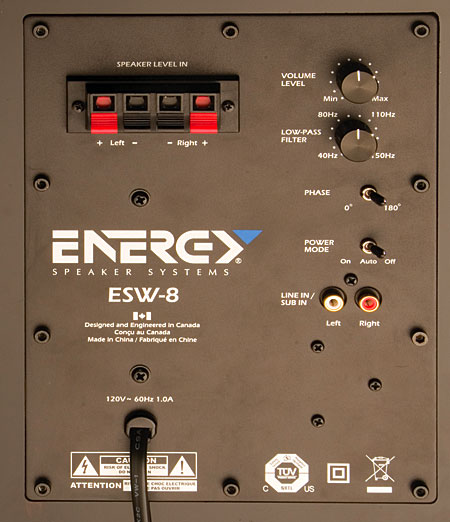Energy Take Classic Speaker System Page 2
In the opening scene, a psychopathic child gives a note-perfect performance of a Beethoven piano sonata, filling the viewer with foreboding. The Take Classic contributed to its chilling perfection with a realistic piano sound, nicely dovetailed in the crossover between the sats and the sub. A later scene brings the musical bookend, this time the psycho-kid’s super-creepy performance of a Dave Matthews song.

Brute force is not the Take Classic’s forte, so to speak. That became apparent in the Dolby Digital 5.1 soundtrack of Sunshine, a sci-fi drama about a space-borne team preparing to jump-start the sun. It’s been cooling off, so their mission is to drive a bomb into it. As is customary in such movies, aggressive effects represent the vastness of space.
The speakers found some timbral nuances in the synthesized roar, which, according to the credits, includes authentic space noise from NASA and “mystic breaths” by the Choristers of Gloucester Cathedral. I also caught a brief reference to the orchestral raveup that concludes “A Day in the Life” by the Beatles. But the Take Classic system inevitably scaled down the brute-force gales of sound intended by the filmmakers, specifically in the LFE channel. There’s only so much a modestly powered sub can accomplish.
In 3:10 to Yuma, also in Dolby Digital 5.1, low-voiced dialogue was unexpectedly the star. It certainly helped that the cast of this comfortingly old-fashioned Western includes Russell Crowe and Christian Bale, both at the top of their form. There are hundreds of rifle shots and even a Gatling gun, but the most engaging moments of the movie lie in tense low-voiced exchanges between the leads, a familiar pair of black-hat/white-hat characters. Thanks to the Take Classics’ effortless low-level resolution, I never had to hike the volume to catch a line.
Take Chances
Preconceptions cheat people of great listening experiences. Here are two examples: “SACD is dead.” And, “You can’t get great sound from little speakers.” I wish you could have heard the Take Classic groove on The Word Is Out!, the second 5.1-channel release from the Jaco Pastorius Big Band on the Heads Up label.
Pristinely recorded to-die-for brass and other textures flooded the room via tunes either written by or associated with Jaco, the late virtuoso bass player. The center channel was inconsistently filled—underuse of the center is a pet peeve of mine—but the mixing engineer did throw in a little muted trumpet here, a little drum sound there. With matching driver arrays in all channels, the Energy system maintained strong timbre-matching, both side to side and front to rear. If I were in retail, I’d be playing this disc for my customers.
R.E.M.’s New Adventures in Hi-Fi was, ironically, not the DVD-Audio surround release but merely a CD. Here, the Take Classic, performing in the Dolby Pro Logic II music mode, presented the tone colors of Peter Buck’s electric guitars and Michael Stipe’s vocals in all their glory and made the best of Stipe’s often elusive enunciation. When I wandered around the room, from sofa to keyboard and back, I was surprised at how little the sound changed—the system’s consistency off axis was excellent. I wanted a meatier rhythm section, though, and whacked up the sub’s volume knob nearly all the way.
I justified my purchase of Glenn Gould: The Complete Original Jacket Collection by simple math. At $222 for 80 discs, I was paying little more than $3 per disc, and I’m betting the price will skyrocket when the box goes out of print. At random, I pulled out a disc covering two Renaissance-era English composers, William Byrd and Orlando Gibbons. The Take Classic’s fairly objective tonal balance was a good match for the limpid plain-vanilla Steinway sound Gould favored.
It came as no surprise to me that Energy’s Take Classic speaker package was such a fine all-around performer. The brand has a strong track record in sat/sub packages, and this set continues the tradition. No, these speakers won’t give you the slamming low-frequency effects you’d get from phat towers and/or a giant sub. But they deliver the midrange goods—the single most important aspect of speaker performance, if I had to choose one—and kept me intelligently entertained.
Highlights
Sleek satellites don’t hog the room
Improved drivers
Multiple mounting options























































